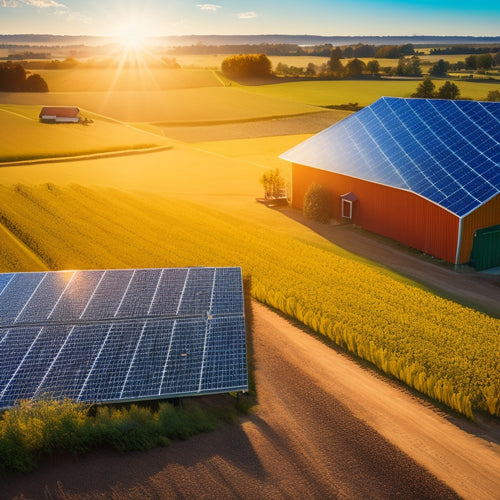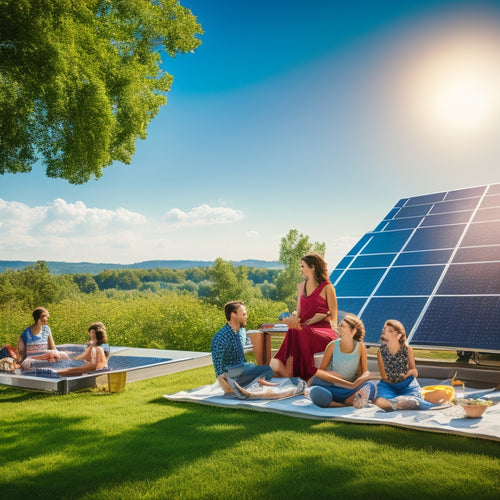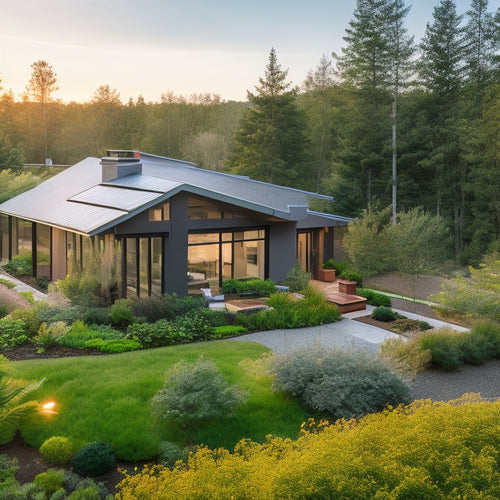
Choosing the Right Solar Panel for Off-Grid Systems
Share
When choosing the right solar panel for your off-grid system, you're faced with a multitude of factors to evaluate. First, accurately assess your energy needs by calculating total wattage, daily operating hours, and usage frequency. Next, assess solar panel types, such as monocrystalline, polycrystalline, thin-film, and bifacial, keeping in mind efficiency, lifespan, and environmental impact. You'll also want to examine efficiency ratings, temperature coefficients, and heat management strategies to optimize power output. As you maneuver through these intricacies, remember that every detail affects your system's performance - and your energy independence depends on making the right choice.
Key Takeaways
- Accurately assess off-grid energy needs to determine the required solar panel size and type for efficient power requirements.
- Consider solar panel types, including monocrystalline, polycrystalline, thin-film, and bifacial, based on efficiency, cost, and environmental impact.
- Evaluate efficiency and power output factors, such as installation techniques, grid compatibility, and temperature impact, to ensure optimal performance.
- Prioritize durability and weather resistance by selecting panels with high IP ratings, sturdy frames, and secure mounting systems.
- Ensure system compatibility by considering voltage, current, and connector compatibility with charge controllers, inverters, and monitoring systems.
Understanding Off-Grid Energy Needs
When living off the grid, your energy needs are largely determined by the appliances and devices you intend to power. To accurately assess your energy requirements, you need to evaluate your energy consumption patterns. This involves calculating the total wattage of each device, the number of hours it operates daily, and the frequency of usage.
Renewable resource availability also plays a significant role in determining your energy needs. Factors such as the amount of sunlight your location receives, wind speeds, and hydro resources will influence the size and type of renewable energy system you require.
By understanding your energy consumption patterns and renewable resource availability, you can determine the appropriate size and configuration of your off-grid system.
Accurate energy needs assessment is essential to guarantee your off-grid system meets your power requirements efficiently and effectively. This will enable you to optimize your system's performance, reduce energy waste, and increase your energy independence.
Solar Panel Types and Technologies
You're now faced with a plethora of solar panel options, each boasting unique characteristics, advantages, and disadvantages.
As you traverse this complex environment, it's crucial to grasp the different types of solar panels and their technologies.
Here are four key types of solar panels to evaluate:
-
Monocrystalline: Offers high efficiency and a long lifespan, making it a popular choice for off-grid systems. However, it's also the most expensive option.
-
Polycrystalline: A cost-effective alternative to monocrystalline, but with slightly lower efficiency and a shorter lifespan.
-
Thin Film: Known for its flexibility and low environmental impact, thin film solar panels are ideal for installations with limited space or unusual mounting requirements.
- Bifacial: Capable of generating energy from both the front and back sides of the panel, bifacial technology can increase overall efficiency by up to 25%.
When selecting a solar panel, evaluate factors such as installation techniques, grid compatibility, and environmental impact.
Efficiency and Power Output Factors
Your solar panel's efficiency and power output are critical factors in determining its overall performance and ability to meet your off-grid energy needs.
When selecting a solar panel, you'll want to take into account the efficiency rating, which is the percentage of sunlight that's converted into electrical energy. Higher efficiency ratings typically result in more power output per unit area. For example, a 300-watt solar panel with a 20% efficiency rating will produce more power than a 300-watt panel with a 15% efficiency rating.
The type of solar panel materials used also impacts efficiency. Monocrystalline silicon panels tend to be more efficient than polycrystalline silicon panels, but are also more expensive. Thin-film panels are less efficient, but often more affordable.
Additionally, installation techniques can affect power output. Proper installation, including ideal tilt and orientation, can increase power output by up to 15%. Shading, temperature, and wiring losses can also impact power output, so it's crucial to take these factors into account when designing your off-grid system.
Panel Size and Weight Considerations
When selecting a solar panel for your off-grid system, you'll want to contemplate the physical constraints of your installation site and transportation options.
Compact design options can be beneficial, as they allow for easier handling and installation in tight spaces.
You should also think about portability and handling requirements, as a lighter and more compact panel can make a big difference in your overall setup and maintenance process.
Compact Design Options
Compact solar panels are designed to maximize energy output while minimizing physical space and weight, making them ideal for off-grid systems where real estate is limited.
You need a panel that can generate enough power without taking up too much space or adding excessive weight to your system.
When it comes to compact design options, you'll want to evaluate the following features:
-
Modular systems: These allow you to connect multiple small panels to achieve your desired energy output, providing flexibility and space optimization.
-
Flexible panels: Made with lightweight materials, these panels can be bent to fit curved surfaces or irregularly-shaped spaces, ensuring aesthetic integration into your off-grid setup.
-
Design innovations: Look for panels with innovative designs that maximize energy output per square inch, such as those with built-in inverters or advanced cell technology.
- Installation options: Assess panels with versatile mounting systems that allow for easy installation on rooftops, walls, or even the ground, providing you with more flexibility in your system design.
Portability and Handling
Between rugged terrain and remote locations, off-grid systems often face unique logistical challenges. When it comes to solar panels, portability and handling become critical factors in guaranteeing a successful installation. As you evaluate your solar panel options, you'll want to think about the size and weight of the panels, as well as the handling techniques required for transportation and installation.
| Panel Size (Watts) | Weight Range (kg) |
|---|---|
| 100-200 | 15-25 |
| 200-300 | 25-40 |
| 300-400 | 40-55 |
| 400-500 | 55-70 |
When assessing solar panel portability, contemplate the dimensions and weight of the panel. Lighter and smaller panels are generally easier to transport and handle, but may not provide as much power. Larger panels, on the other hand, may require more handling techniques, such as specialized equipment or additional personnel, but can generate more power. As you weigh your options, be certain to evaluate the trade-offs between power output, portability, and handling complexity. By selecting a panel that balances these factors, you can guarantee a successful off-grid installation that meets your power needs.
Durability and Weather Resistance
How well can your solar panel withstand the harsh outdoor environment? Durability and weather resistance are essential factors to take into account when choosing a solar panel for off-grid systems. You need a panel that can withstand weather extremes, from scorching deserts to torrential rains.
Here are some key aspects to evaluate:
-
IP Rating: Look for a panel with a high IP (Ingress Protection) rating, which indicates its resistance to solid particles and water.
-
Frame and Mounting: Verify the frame is sturdy and the mounting system is secure to prevent damage from wind and snow loads.
-
Glass or Plastic Cover: A tempered glass cover provides better protection than plastic, but it's heavier and more expensive.
- Certifications: Check for certifications like IEC 61215 and UL 1703, which guarantee the panel's durability and performance in various environmental conditions.
A durable solar panel can last up to 30 years or more, guaranteeing a longer panel lifespan and minimizing the need for frequent replacements.
Temperature Coefficient and Performance
When selecting a solar panel for your off-grid system, you'll want to contemplate how temperature affects its performance.
High temperatures can reduce a panel's efficiency, resulting in heat-induced power loss, and understanding this impact is vital for ideal system design.
You'll need to evaluate a panel's temperature coefficient to determine how well it can maintain its performance in hot conditions.
High Temperature Effects
Operating in high temperatures, your off-grid solar panel system faces reduced energy output, a critical consideration in regions with scorching summers.
High temperatures can greatly impact your system's performance, and it's vital to understand how to mitigate these effects.
The temperature coefficient of your solar panel, usually represented as a percentage per degree Celsius, indicates how much the panel's efficiency decreases as the temperature rises.
A lower temperature coefficient means your panel will perform better in hot conditions. When selecting a solar panel, look for one with a temperature coefficient close to -0.4%/°C or lower.
To guarantee ideal performance, consider the following temperature management strategies:
- Mounting options: Raised or tilted mounting can improve airflow and reduce temperatures.
- Cooling systems: Active or passive cooling systems can help maintain ideal operating temperatures.
- Shading: Strategic shading can reduce direct sun exposure and lower temperatures.
- Panel selection: Choose panels with high temperature tolerance and low temperature coefficients.
Proper temperature management can extend your solar panel lifespan and guarantee consistent energy output, even in the hottest conditions.
Impact on Efficiency
As you strive to optimize your off-grid solar panel system's performance, the impact of high temperatures on efficiency becomes a key concern. High temperatures can greatly reduce your solar panel's power output, affecting its overall performance and lifespan.
| Temperature Coefficient | Impact on Efficiency |
|---|---|
| -0.45%/°C | For every 1°C increase above 25°C, the solar panel's efficiency decreases by 0.45%. |
| -0.50%/°C | A higher temperature coefficient indicates a greater drop in efficiency at higher temperatures. |
| Installation Techniques | Proper installation techniques, such as ensuring adequate airflow and using a white roof, can help mitigate heat-related efficiency losses. |
| Solar Panel Lifespan | High temperatures can also affect a solar panel's lifespan, with increased temperatures potentially reducing its lifespan by up to 1-2 years. |
| Performance Ratio | A solar panel's performance ratio is also affected by high temperatures, with a lower ratio indicating a greater impact on efficiency. |
Heat-Induced Power Loss
Every degree of temperature increase above 25°C can result in a significant power loss, directly impacting your off-grid system's overall performance.
When selecting a solar panel, it's crucial to take into account the temperature coefficient, which measures the panel's efficiency loss per degree of temperature increase. A lower temperature coefficient means less power loss due to heat.
To mitigate heat-induced power loss, you should:
-
Opt for panels with a low temperature coefficient: Look for panels with a temperature coefficient of -0.4% or lower to minimize efficiency loss.
-
Implement heat management strategies: Guarantee proper airflow around the panels and think about using thermal insulation to reduce heat buildup.
-
Monitor panel temperature: Keep an eye on panel temperatures to identify potential issues and take corrective action.
- Select panels designed for high-temperature operation: Some panels are specifically designed to perform well in hot climates; consider these options for your off-grid system.
Budget and Cost Effectiveness
When selecting a solar panel for your off-grid system, budget and cost-effectiveness are vital considerations, given that you'll likely be relying on this setup as your primary power source. A thorough cost analysis is fundamental to determine the best value for your money. You should consider not only the upfront cost of the solar panel but also the long-term benefits, such as reduced energy bills and potential financial incentives.
| Solar Panel Model | Cost per Watt | Total Cost (5 kW System) |
|---|---|---|
| Monocrystalline | $2.50 | $12,500 |
| Polycrystalline | $2.20 | $11,000 |
| Thin-Film | $1.80 | $9,000 |
When evaluating the cost-effectiveness of different solar panels, consider factors such as efficiency, durability, and warranty. While more efficient panels may cost more upfront, they can provide greater long-term savings. Additionally, look for financial incentives, such as tax credits or rebates, that can help offset the initial investment. By carefully considering your budget and the total cost of ownership, you can choose a solar panel that meets your power needs while staying within your budget.
Compatibility With System Components
Selecting a solar panel that seamlessly integrates with your off-grid system's components is essential for ideal performance and efficiency. You need to confirm that the panel you choose is compatible with your system's components, including the charge controller, inverter, and battery bank.
To achieve this, you should consider the following key factors in your system compatibility assessments:
-
Voltage and current ratings: Confirm the solar panel's voltage and current ratings match those of your charge controller and inverter.
-
Connectors and wiring: Verify that the panel's connectors and wiring are compatible with your system's components.
-
Maximum power point tracking (MPPT): If your charge controller has MPPT, confirm the solar panel is compatible with this feature.
- Monitoring and tracking capabilities: Consider panels with built-in monitoring and tracking capabilities that can integrate with your system's monitoring system.
Certifications and Compliance Standards
As you maneuver through the process of choosing a solar panel for your off-grid system, confirming compliance with relevant certifications and standards is vital to secure the panel's performance, safety, and reliability.
When evaluating solar panels, look for certifications from reputable bodies such as UL (Underwriters Laboratories) or IEC (International Electrotechnical Commission). These certifications ascertain the panel meets specific testing standards for safety, performance, and environmental impact.
Compliance with regulations like IEEE (Institute of Electrical and Electronics Engineers) standards and NEC (National Electric Code) requirements is also fundamental.
Safety certifications, such as UL 1703 or IEC 61215, verify the panel's ability to withstand environmental stresses and operating conditions. Quality assurance standards, like ISO 9001, guarantee the manufacturer's quality management system meets international standards.
Frequently Asked Questions
Can I Mix and Match Solar Panels From Different Manufacturers?
You can mix and match solar panels from different manufacturers, but be aware that panel compatibility issues may arise, potentially affecting performance efficiency, so guarantee compatible voltage, current, and connector types to optimize your system's overall energy production.
Are There Any Solar Panels Specifically Designed for Marine Use?
As you set sail on the open sea, you'll want solar panels that can weather the storm; marine solar panels, designed specifically for marine use, offer flexible panels that can withstand harsh saltwater environments and intense UV rays.
Do Solar Panels Work Well in Shaded or Partially Shaded Areas?
You'll find that solar panels don't work well in shaded or partially shaded areas, as shaded performance considerably reduces solar panel efficiency; even slight shading can decrease energy output by up to 80%, highlighting the importance of ideal panel placement.
Can I Use a Single Solar Panel to Charge Multiple Batteries?
You can use a single solar panel to charge multiple batteries, like in a rural village project where one 300-watt panel charged three 12V batteries in parallel, optimizing battery capacity and charging efficiency.
Are There Any Solar Panels With Built-In Inverters Available?
You'll find solar panels with built-in inverters, known as AC modules, which integrate an inverter into each panel, enhancing solar efficiency and convenience; these innovative designs simplify installation and monitoring, making them a great option for your off-grid power needs.
Conclusion
As you steer through the vast terrain of off-grid solar panels, remember that the right choice is like finding the North Star - it directs your entire system towards efficiency and reliability. With a clear understanding of your energy needs, you've charted a course through the intricacies of panel types, efficiency, and durability. Now, with your guiding light in hand, you're ready to illuminate your off-grid path, utilizing the power of the sun to fuel your independence.
Related Posts
-

Off-Grid Solar Solutions for Sustainable Farming
Off-grid solar solutions can revolutionize your farming operations by providing energy independence and significant c...
-

Solar Power Savings for Environmentally Aware Consumers
Switching to solar power lets you drastically cut your carbon footprint while saving money in the long run. Each kilo...
-

Sustainable Home Design for Reduced Carbon Footprint
Sustainable home design is your pathway to a smaller carbon footprint and a healthier living space. By incorporating ...


